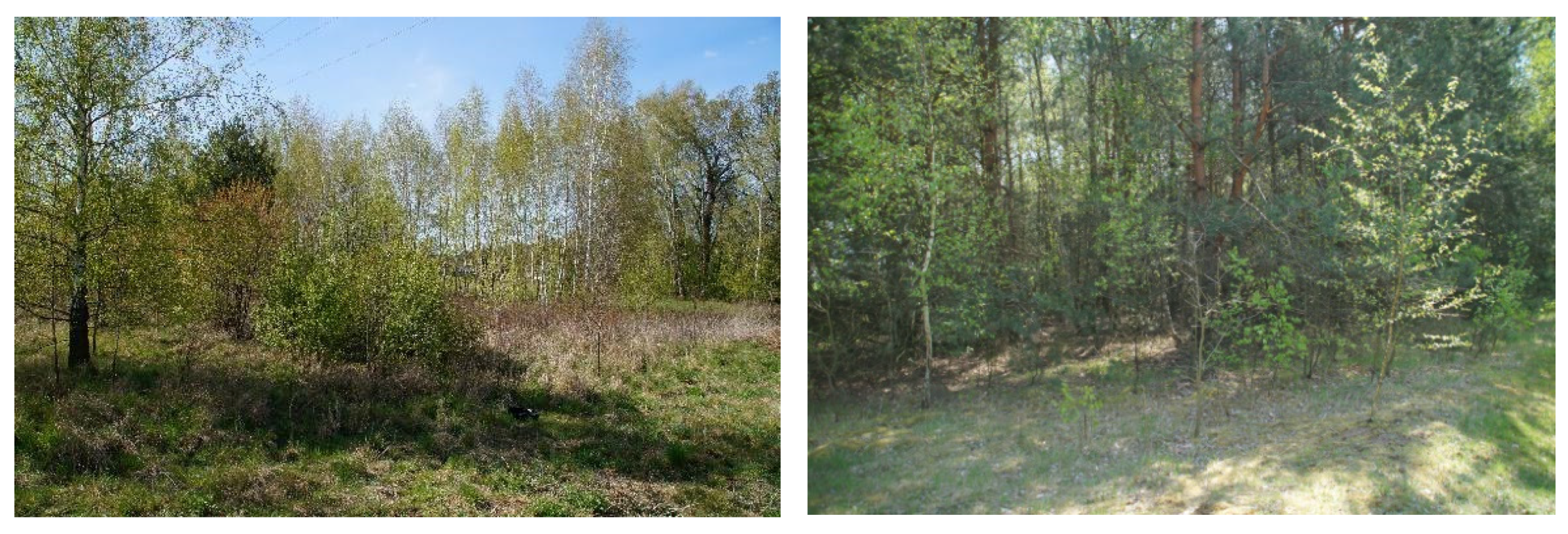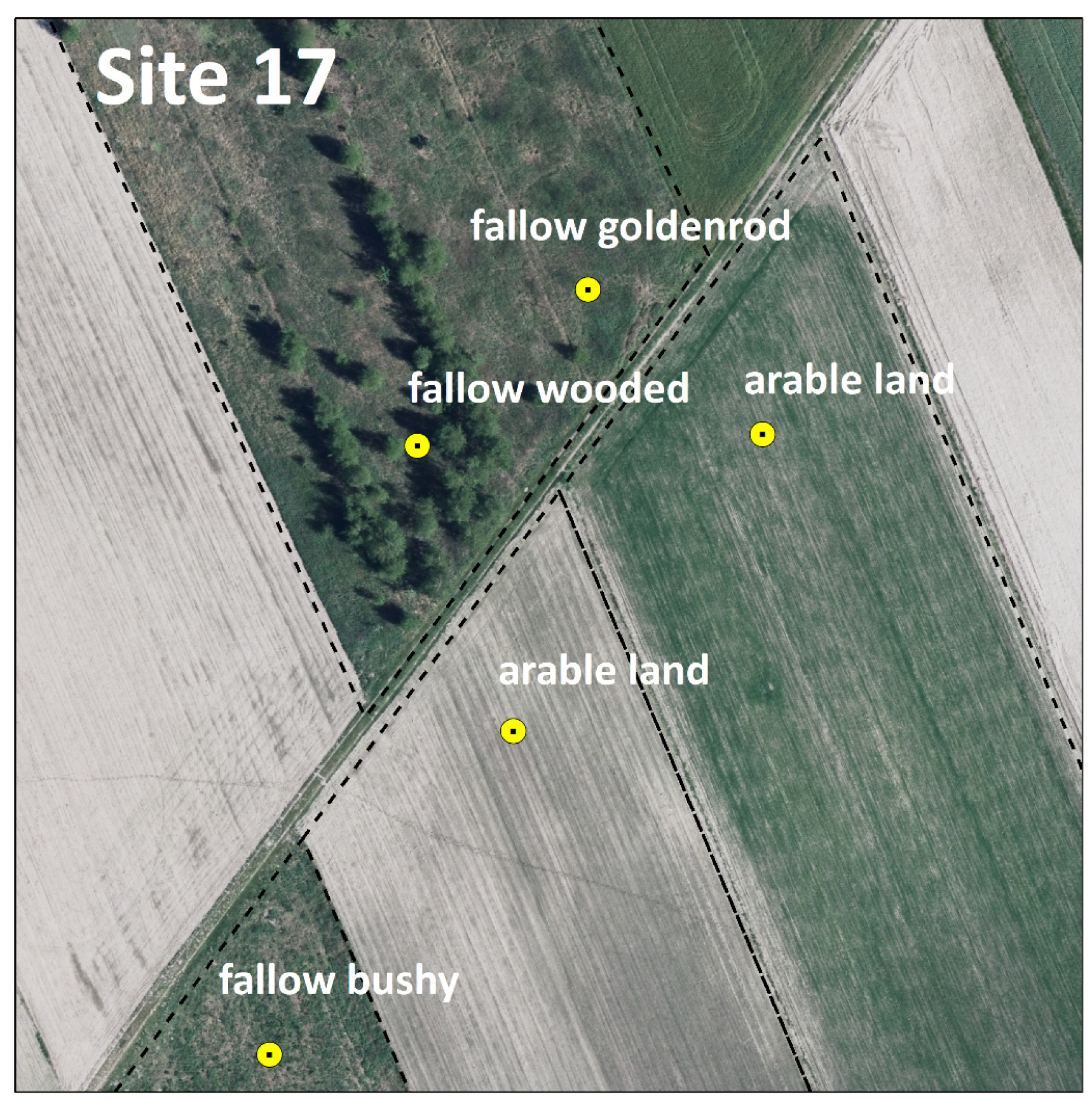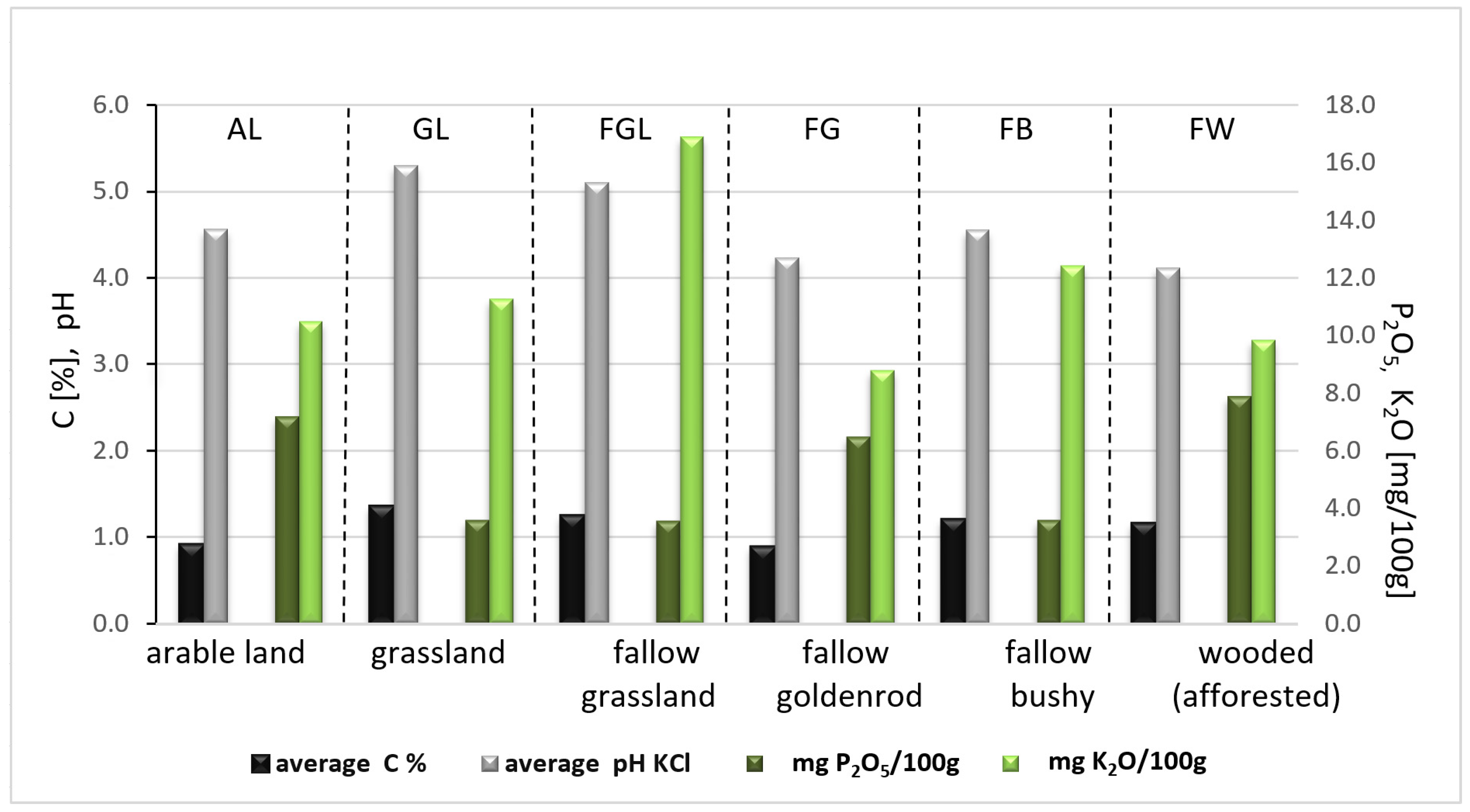Impact Assessment of the Long-Term Fallowed Land on Agricultural Soils and the Possibility of Their Return to Agriculture
Abstract
1. Introduction
1.1. The Process of Setting Aside/Fallowing Land in the Political and Environmental Context
- Naturality (with or without controlled natural succession),
- Multi-functionality (e.g., extensive agricultural production, hobby farming (traditional, small-scale food production, agri-tourism),
- Productivity—sustainable agricultural production or bioenergy and renewable energy sources.
1.2. Testing Conditions of the Fallow Soil
2. Material and Methods
2.1. Main Assumptions
- A region representative of the country was selected, where fallowing agricultural land is a serious problem for agriculture.
- Materials were collected to track the course and dynamics of the fallowing process.
- Basic types of fallow land were defined with their location on the map of the research area.
- For selected sites, the impact of fallowing on the soil condition was analyzed—by determining its chemical properties and comparing it with soil samples collected in adjacent agricultural fields.
2.2. Area of Research
2.3. Spatial Data Collection
- Geo-referenced photos taken in-situ during visits at the selected sites (for examples, see Section 2.4).
2.4. Definition of Fallow Types
- Grassland (FGL)—mostly newly abandoned agricultural land, possibly fallow land, with a predominance of grassland vegetation, with only a few plantings of later succession, e.g., goldenrod (Solidago L.) (Figure 3).
- Goldenrod (FG)—areas with a predominance of plants of later succession stages, mainly goldenrod (Solidago L.), tansy (Tanacetum vulgare L.). Criterion: Over 80% share of goldenrod or tansy in land cover (Figure 4).
- Bushy (FB)—areas where apart from ruderal plants, such as goldenrod (Solidago L.), there are bushes, e.g., in the form of blackberries (Rubus L.), blackthorn (Prunus spinosa L.) and single self-seeded trees. Criterion: Over 30% share of bushes in land cover (Figure 5).
- Wooded/afforested (FW)—areas with trees, dense shrubs, advanced succession. Criterion: Samples were taken in places where young forest covered at least 0.10 ha (Figure 6).
2.5. Field Work, Soil Sampling and Laboratory Tests
- Each tested fallowed parcel has to have a fallowing period documented on the aerial photographs, and meet the marginality criteria for agricultural plots, defined by Pudełko et al. [5].
- In the immediate vicinity of the fallow plot, there are agricultural plots with similar site conditions (soil class, topography, water conditions), with no episodes of fallowing.
- One site must consist of at least one fallow plot and one utilized agricultural plot (arable land). However, most often chosen sites offered several types of succession in the unutilized field and both types of land use the utilized field (arable and grassland)—see Figure 7.
2.6. Statistical Analyses
- 8 pairs of arable (AL) and grassland, former arable (GL),
- 6 pairs of arable and fallow grassland (FGL),
- 17 pairs of arable and fallow goldenrod (FG),
- 15 pairs of arable and fallow bush (FB),
- 13 pairs of arable and fallow wood (FW).
3. Result
3.1. Changes in Carbon Content
3.2. Changes in pH
3.3. Changes in K2O and P2O5 Content
3.4. Principal Component Analysis (PCA)
4. Discussion
4.1. Impact of Fallowing on Soil
4.2. Possibility of Returning Fallow Land to Agriculture
5. Conclusions
- Basic soil parameters, such as the content of organic matter and its acidity—do not deteriorate noticeably during the process of setting aside. In this case, the research hypothesis is accepted at a significance level α < 0.05.
- Fallowing shows significant effect on the content of potassium and phosphorus in the soil. In this case, the research hypothesis is satisfied at a significance level α ~ 0.15 (P2O5) and α ~ 0.1 (K2O). However, fertilization with these components is, in the case of agricultural use, a typical agrotechnical treatment that effectively increases soil fertility.
- Among the examined types of fallow, maintaining it with succession of goldenrod (Solidago L.) is the least favorable.
- Changes in the dependence and correlation of the analyzed soil properties are observed in the tested types of use and fallowing. Long-term fallow, which develops mature forms of succession (trees, shrubs), diversifies the carbon content and the acidity of the soil. In this case, a positive aspect is the increase in the content of organic matter in the soil, but at the same time increases also its acidity.
- For agricultural plots where the deterioration of soil conditions has been observed, these conditions can be quickly restored for the selected type of biomass production by applying agro-technical practices in accordance with the recommendations of the Code of Good Agricultural Practices [47].
Supplementary Materials
Author Contributions
Funding
Institutional Review Board Statement
Informed Consent Statement
Data Availability Statement
Acknowledgments
Conflicts of Interest
References
- Michna, W.; Rokicka, W. Low quality soils, their agricultural use and economic marginalisation. In Rationalisation of the Use of Marginal Soils; IERiGŻ: Warsaw, Poland, 1998; pp. 85–92. (In Polish) [Google Scholar]
- Kolecka, N.; Kozak, J.; Kaim, D.; Dobosz, M.; Ostafin, K.; Ostapowicz, K.; Wężyk, P.; Prince, B. Understanding Farmland Abandonment in the Polish Carpathians. Appl. Geogr. 2017, 88, 62–72. [Google Scholar] [CrossRef]
- Krysiak, S. Fallow lands in the landscapes of central Poland—Spatial, typological and ecological aspects. Probl. Landsc. Ecol. 2011, 41, 89–96. (In Polish) [Google Scholar]
- Lasanta, T.; Nadal-Romero, E.; Arnáez, J. Managing abandoned farmland to control the impact of re-vegetation on the environment. The state of the art in Europe. Environ. Sci. Policy 2015, 52, 99–109. Available online: https://linkinghub.elsevier.com/retrieve/pii/S1462901115001094 (accessed on 12 December 2020). [CrossRef]
- Pudełko, R.; Kozak, M.; Jędrejek, A.; Gałczyńska, M.; Pomianek, B. Regionalisation of unutilised agricultural area in Poland. Polish J. Soil Sci. 2018, 51, 119–132. [Google Scholar] [CrossRef]
- Beilin, R.; Lindborg, R.; Stenseke, M.; Pereira, H.M.; Llausàs, A.; Slätmo, E.; Cerqueira, Y.; Navarro, L.; Rodrigues, P.; Reichelt, N.; et al. Analysing how drivers of agricultural land abandonment affect biodiversity and cultural landscapes using case studies from Scandinavia, Iberia and Oceania. Land Use Policy 2014, 36, 60–72. [Google Scholar] [CrossRef]
- Ortyl, B.; Ćwik, A.; Kasprzyk, I. What Happens in a Carpathian Catchment after the Sudden Abandonment of Cultivation? Catena 2018, 166, 158–170. [Google Scholar] [CrossRef]
- Janus, J.; Bozek, P. Land Abandonment in Poland after the Collapse of Socialism: Over a Quarter of a Century of Increasing Tree Cover on Agricultural Land. Ecol. Eng. 2019, 138, 106–117. [Google Scholar] [CrossRef]
- Novara, A.; Gristina, L.; Sala, G.; Galati, A.; Crescimanno, M.; Cerdà, A.; Badalamenti, E.; La Mantia, T. Agricultural land abandonment in Mediterranean environment provides ecosystem services via soil carbon sequestration. Sci. Total Environ. 2017, 576, 420–429. [Google Scholar] [CrossRef]
- Radzikowski, P.; Matyka, M.; Berbeć, A.K. Biodiversity of Weeds and Arthropods in Five Different Perennial Industrial Crops in Eastern Poland. Agriculture 2020, 10, 636. [Google Scholar] [CrossRef]
- Van der Zanden, E.H.; Verburg, P.H.; Schulp, C.J.E.; Verkerk, P.J. Trade-Offs of European Agricultural Abandonment. Land Use Policy 2017, 62, 290–301. [Google Scholar] [CrossRef]
- Orczewska, A. Who is more dangerous: The alien or the native? The negative impact of Solidago gigantea, Urtica dioica and Galium aparine on the herbaceous woodland species in recent post-agricultural alder woods. Stud. Mater. CEPL 2012, 14, 217–225. (In Polish) [Google Scholar]
- Sekutowski, T.; Włodek, S.; Biskupski, A.; Sienkiewicz-Cholewa, U. Comparison of the content of seeds and plants of the goldenrod (Solidago sp.) in the fallow and adjacent field. Zesz. Nauk. UP Wroclaw 2012, 584, 99–111. (In Polish) [Google Scholar]
- Bell, S.; Barriocanal, C.; Terrer, C.; Rosell-Melé, A. Management Opportunities for Soil Carbon Sequestration Following Agricultural Land Abandonment. Environ. Sci. Policy 2020, 108, 104–111. [Google Scholar] [CrossRef]
- Stolarski, M.J.; Szczukowski, S.; Krzyzaniak, M.; Tworkowski, J. Energy Value of Yield and Biomass Quality in a 7-Year Rotation of Willow Cultivated on Marginal Soil. Energies 2020, 13, 2144. [Google Scholar] [CrossRef]
- Stolarski, M.J.; Niksa, D.; Krzyżaniak, M.; Tworkowski, J.; Szczukowski, S. Willow Productivity from Small- and Large-Scale Experimental Plantations in Poland from 2000 to 2017. Renew. Sustain. Energy Rev. 2019, 101, 461–475. [Google Scholar] [CrossRef]
- Berbeć, A.K.; Matyka, M. Planting Density Effects on Grow Rate, Biometric Parameters, and Biomass Calorific Value of Selected Trees Cultivated as SRC. Agriculture 2020, 10, 583. [Google Scholar] [CrossRef]
- Matyka, M.; Radzikowski, P. Productivity and Biometric Characteristics of 11 Varieties of Willow Cultivated on Marginal Soil. Agriculture 2020, 10, 616. [Google Scholar] [CrossRef]
- Von Cossel, M.; Lewandowski, I.; Elbersen, B.; Staritsky, I.; Van Eupen, M.; Iqbal, Y.; Mantel, S.; Scordia, D.; Testa, G.; Cosentino, S.L.; et al. Marginal Agricultural Land Low-Input Systems for Biomass Production. Energies 2019, 12, 3123. [Google Scholar] [CrossRef]
- IPCC. Climate Change and Land Ice. In IPCC Special Report on Climate Change, Desertification, Land Degradation, Sustainable Land Management, Food Security, and Greenhouse Gas Fluxes in Terrestrial Ecosystems; Summary for Policymakers; IPPC: Rome, Italy, 2017; pp. 1–15. [Google Scholar]
- Kazlauskaite-Jadzevice, A.; Tripolskaja, L.; Volungevicius, J.; Baksiene, E. Impact of Land Use Change on Organic Carbon Sequestration in Arenosol. Agric. Food Sci. 2019, 28, 9–17. [Google Scholar] [CrossRef]
- Foote, R.L.; Grogan, P. Soil Carbon Accumulation during Temperate Forest Succession on Abandoned Low Productivity Agricultural Lands. Ecosystems 2010, 13, 795–812. [Google Scholar] [CrossRef]
- Yang, Y.; Tilman, D.; Furey, G.; Lehman, C. Soil carbon sequestration accelerated by restoration of grassland biodiversity. Nat. Commun. 2019, 10, 718. [Google Scholar] [CrossRef]
- Karhu, K.; Wall, A.; Vanhala, P.; Liski, J.; Esala, M.; Regina, K. Effects of afforestation and aeforestation on boreal soil carbon stocks-Comparison of measured C stocks with Yasso07 model results. Geoderma 2011, 164, 33–45. [Google Scholar] [CrossRef]
- Lozano-García, B.; Francaviglia, R.; Renzi, G.; Doro, L.; Ledda, L.; Benítez, C.; González-Rosado, M.; Parras-Alcántara, L. Land Use Change Effects on Soil Organic Carbon Store. An Opportunity to Soils Regeneration in Mediterranean Areas: Implications in the 4p1000 Notion. Ecol. Indic. 2020, 106831. [Google Scholar] [CrossRef]
- Zhang, Z.; Han, X.; Yan, J.; Zou, W.; Wang, E.; Zou, W.; Wang, E.; Lu, X.; Chen, X. Keystone Microbiomes Revealed by 14 Years of Field Restoration of the Degraded Agricultural Soil Under Distinct Vegetation Scenarios. Front. Microbiol. 2020, 11, 1–13. [Google Scholar] [CrossRef]
- Strączyńska, S.; Strączyński, S.; Wojciechowski, W. Effect of different land uses on selected properties of the soils. Soil Sci. Ann. 2010, 61, 227–232. (In Polish) [Google Scholar]
- Tomaszewicz, T.; Chudecka, J. Influence of land use on properties of rusty soils: Fallow and agricultural use in Ginawa. Agric. Eng. 2005, 4, 311–320. (In Polish) [Google Scholar]
- Włodek, S.; Sienkiewicz-Cholewa, U.; Biskupski, A.; Sekutowski, T.R. Comparison of the chosen environmental features of the arable land and fallow. Ecol. Eng. 2014, 38, 51–59. (In Polish) [Google Scholar]
- Licznar, M.; Licznar, S.E.; Walenczak, K.; Brojanowska, M. Humic substances of fallowed soils against a background of their physicochemical properties. Ann. Soil Sci. 2009, 60, 69–76. (In Polish) [Google Scholar]
- Biomagic, BIOproducts from Lignocellulosic Biomass Derived from MArginal Land to Fill the Gap in Current National Bioeconomy, 2017–2020. Available online: http://www.uwm.edu.pl/cbeo/projekty/biomagic (accessed on 30 December 2020).
- GUS. Central Statistical Office. Natl. Agric. Census. 2010. Available online: https://bdl.stat.gov.pl/BDL/dane/podgrup/temat (accessed on 6 December 2020).
- GUGiK: The Head Office of Geodesy and Cartography. Available online: https://www.geoportal.gov.pl/#(1) (accessed on 10 December 2020).
- SIS Pulawy, Spatial Information System of the Puławy poviat. Available online: http://sip.pulawy.powiat.pl/ (accessed on 10 December 2020).
- Mocek, A. Soil Science, 1st ed.; PWN: Warsaw, Poland, 2014; pp. 201–224. (In Polish) [Google Scholar]
- Systematyka gleb Polski (Polish soil classification). Rocz. Glebozn. Soil Sci. Ann. 2011, 62, 1–193.
- Smreczak, B.; Łachacz, A. Soil Types Specified in the Bonitation Classification and Their Analogues in the Sixth Edition of the Polish Soil Classification. Soil Sci. Ann. 2019, 70, 115–136. [Google Scholar] [CrossRef]
- Stępień, M.; Bodecka, E.; Gozdowski, D.; Wijata, M.; Groszyk, J.; Studnicki, M.; Sobczyński, G.; Rozbicki, J.; Samborski, S. Compatibility of granulometric groups determined based on standard BN-78/9180-11 and granulometric groups according to PTG 2008 and USDA texture classes. Soil Sci. Ann. 2018, 69, 223–233. [Google Scholar] [CrossRef]
- Ostrowska, A.; Gawliński, S.; Szczubiałka, Z. Methods of Analysis and Evaluation of the Properties of Soils and Plants; Catalog Institute of Environmental Protection: Warsaw, Poland, 1991; pp. 89–93. [Google Scholar]
- Jambu, M. Exploratory and Multivariate Data Analysis; Academic Press: New York, NY, USA, 1991; pp. 125–160. [Google Scholar]
- Sapek, B. Loss prevention and organic carbon sequestration in meadow soils. Ecol. Eng. 2009, 21, 48–61. (In Polish) [Google Scholar]
- Mengel, K.; Kirkby, E.A. Principles of plant nutrition. Ann. Bot. 2004, 93, 479–480. [Google Scholar] [CrossRef]
- Zawadzki, S. Soil Sience, 4th ed.; PWRiL: Warsaw, Poland, 1999; pp. 183–220. [Google Scholar]
- Directive 2009/28/EC of the European Parliament and of the Council of 23 April 2009 on the promotion of the use of energy from renewable sources and amending and subsequently repealing Directives 2001/77/EC and 2003/30/EC. Off. J. Eur. Union 2009, 5, 2009.
- The Act on Renewable Energy Sources, 20 February 2015. Dz. U. 2015 poz. 478 (Polish Legal Regulation). Available online: https://isap.sejm.gov.pl/isap.nsf/download.xsp/WDU20150000478/U/D20150478Lj.pdf (accessed on 20 December 2020).
- European Commission: Commission Staff Working Document. Analysis of links between CAP Reform and Green Deal. Brussels SWD 2020. Available online: https://ec.europa.eu/info/sites/info/files/food-farming-fisheries/sustainability_and_natural_resources/documents/analysis-of-links-between-cap-and-green-deal_en.pdf (accessed on 20 December 2020).
- Duer, I.; Fotyma, M.; Madej, A. Code of Good Agricultural Practices; MRiRW MŚ FAPA: Warsaw, Poland, 2004. (In Polish) [Google Scholar]










| Land Use | SD (C%) | SD (pH) | SD (P2O5) | SD (K2O) |
|---|---|---|---|---|
| arable land (AL) | 0.25 | 0.80 | 7.45 | 5.70 |
| grassland (GL) | 0.71 | 0.86 | 4.54 | 3.06 |
| grassland fallow (FGL) | 0.07 | 0.75 | 3.19 | 5.79 |
| goldenrod fallow (FG) | 0.27 | 0.83 | 6.28 | 5.29 |
| bushy fallow (FB) | 0.41 | 1.11 | 5.92 | 7.23 |
| wooded (afforested)—FW | 0.26 | 0.86 | 4.89 | 16.41 |
Publisher’s Note: MDPI stays neutral with regard to jurisdictional claims in published maps and institutional affiliations. |
© 2021 by the authors. Licensee MDPI, Basel, Switzerland. This article is an open access article distributed under the terms and conditions of the Creative Commons Attribution (CC BY) license (http://creativecommons.org/licenses/by/4.0/).
Share and Cite
Kozak, M.; Pudełko, R. Impact Assessment of the Long-Term Fallowed Land on Agricultural Soils and the Possibility of Their Return to Agriculture. Agriculture 2021, 11, 148. https://doi.org/10.3390/agriculture11020148
Kozak M, Pudełko R. Impact Assessment of the Long-Term Fallowed Land on Agricultural Soils and the Possibility of Their Return to Agriculture. Agriculture. 2021; 11(2):148. https://doi.org/10.3390/agriculture11020148
Chicago/Turabian StyleKozak, Małgorzata, and Rafał Pudełko. 2021. "Impact Assessment of the Long-Term Fallowed Land on Agricultural Soils and the Possibility of Their Return to Agriculture" Agriculture 11, no. 2: 148. https://doi.org/10.3390/agriculture11020148
APA StyleKozak, M., & Pudełko, R. (2021). Impact Assessment of the Long-Term Fallowed Land on Agricultural Soils and the Possibility of Their Return to Agriculture. Agriculture, 11(2), 148. https://doi.org/10.3390/agriculture11020148







